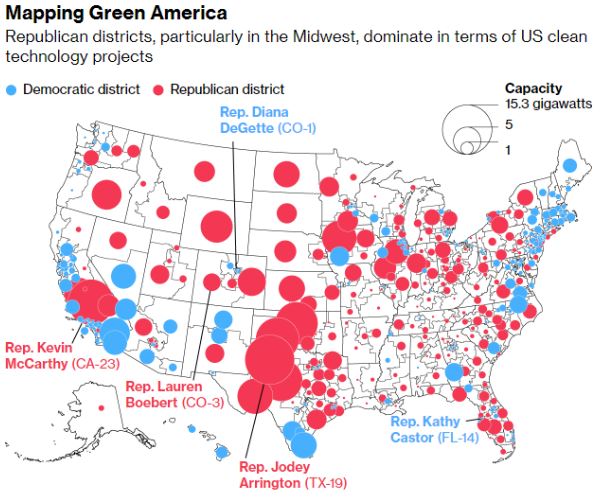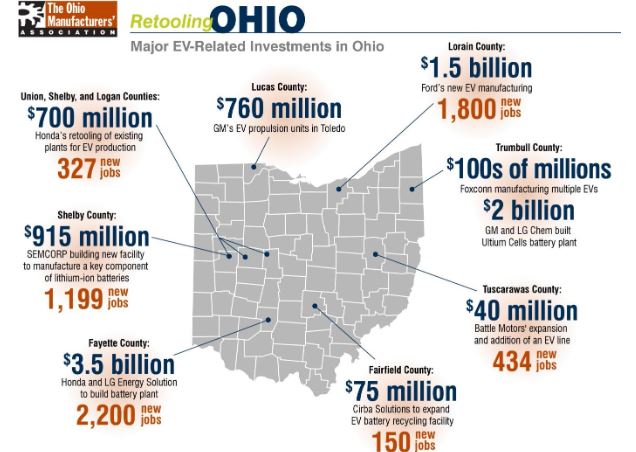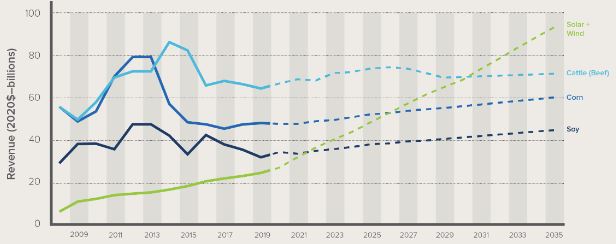 How the Inflation Reduction Act can bridge the partisan divide
How the Inflation Reduction Act can bridge the partisan divide
By Jonathan Marshall
The Inflation Reduction Act (IRA) squeaked through Congress last summer on a strictly partisan vote, clearing the Senate with a bare one-vote majority. Yet one of its most profound long-term impacts may be bringing more Republicans around to supporting clean technology. If so, its reorientation of our national political debate may prove as important for climate mitigation as its direct support for renewable energy, heat pumps, and electric vehicles.
Two months before the IRA passed, when its future still looked bleak, two environmental policy scholars at the University of California – Berkeley published an article on “The Climate Advocacy Gap” in the journal “Climatic Change.” Their detailed analysis of state government policymaking revealed that “States like Iowa, Nebraska, Kansas, Oklahoma, and Utah — all states rich in renewable energy resources — have greater representation of clean energy interests than their politics would suggest. Here, the economic opportunity of renewable energy development creates and attracts clean energy interests, to some extent narrowing the pro-climate advocacy gap in Republican-leaning states.”
In a concluding discussion, they suggested that environmental groups should get out of their comfort zones and engage more with Republicans, particularly in “renewable-resource-rich states.” To that end, they observed, “investments under the Biden administration’s climate investment policies offer an important opportunity . . . to shift the landscape of climate advocacy . . . by creating and growing clean energy interests. In times of ideological polarization, the development of economic advocacy groups represents a pragmatic approach to strengthening climate advocacy in laggard states and to begin to narrow the climate advocacy gap.”
The half-trillion-dollar opportunity
The “opportunity” created by federal climate investments is far bigger than most people realize. Between the 2021 infrastructure bill, the 2022 CHIPS and Science Act, and IRA, federal investments in the green economy will exceed half a trillion dollars over the next decade. Spending will flow at a rate about 3.5 times greater than during the Obama administration, according to RMI.
All that public money is really a lever to unleash trillions of dollars in new private investment. The trade group American Clean Power reported that in just three months following the passage of the IRA, companies announced $40 billion in new clean energy investments, ranging from solar manufacturing plants to battery storage facilities. That’s equal to spending in the sector during all of 2021.
As a resident of the great green state of California, I’ve noticed that project after project is going to red states where taxes, wages, and land prices are lower. Honda and LG Energy said they plan to invest $4 billion in a new EV battery plant in Ohio that will employ more than 2,000 people. BMW will invest $1.7 billion in an EV manufacturing plant in South Carolina. Taking advantage of tax credits in the IRA, two major energy companies plan to build a $4 billion renewable hydrogen project in northern Texas. The Department of Energy announced in December it will issue $2.5 billion in loans to start lithium battery manufacturing hubs in Ohio, Tennessee, and Michigan.
“There’s a giant wave of battery manufacturing heading toward the U.S. because of the (Inflation Reduction Act),” said the CEO of battery recycler Redwood Materials, who plans to open a $3.5 billion plant in South Carolina. “They’re expanding, especially in the Southeast, creating this so-called battery belt between Michigan and Georgia. That’s part of the calculus for us on why we want to develop a footprint right in the middle of the region to support that.”
Source: TVA
Republican governors, ignoring the snide dismissals of clean energy in some ideological publications, can’t get enough. Texas Gov. Greg Abbott sang the praises of the renewable hydrogen project in December, saying it would turn his state into a “global powerhouse” for hydrogen and bring “hundreds of jobs and millions in revenue to the Lone Star State.” As if to challenge Texas, Oklahoma Rep. Stephanie Bice, another Republican, introduced a bipartisan bill to authorize additional research funding for clean hydrogen, saying, “Oklahoma is striving to become a leader in hydrogen production, transportation, and storage.”
An even greater enthusiast, Ohio Republican Governor Mike DeWine, officially recognized the end of September as National Clean Energy Week. “The clean energy sector is a growing industry and economic driver of job creation in Ohio, with over 103,000 clean energy jobs in the Buckeye state,” he declared.
Credit: Ohio Manufacturers Association
Actually, it turns out that California is benefiting as well — no place more than the 23rd congressional district, represented by Kevin McCarthy, who has held multiple leadership positions as a House Republican. According to Bloomberg, “his district ranks No. 1 in the nation for planned and operating grid-battery projects. McCarthy’s district also ranks first for planned and operating utility-scale solar capacity and second when you combine wind, solar and batteries. That is one green deep-red district.”
Nationwide, the Bloomberg report adds, Republicans represent 16 of the top 21 districts where major new solar, wind, and battery projects are planned.
Source: US Green Energy Budgets Pushed by Democrats Get Spent on Republicans – Bloomberg
Last summer’s clean tech stimulus legislation simply accelerated an investment trend that’s been underway for years. A 2021 report by RMI noted that with demand for renewable energy soaring, “rural communities—which host 99 percent of onshore wind and a growing share of utility-scale solar projects—stand to receive a sizable boost to their local economies. In fact, annual revenues from wind and solar projects could exceed $60 billion dollars by 2030—on par with expected revenues from the top three US agricultural commodities: corn, soy, and beef production.” In political terms, that means a huge flow of clean-tech jobs and revenue into Republican districts.
Source: Seeds of Opportunity – RMI
The changing economic landscape for red districts could well cause a political realignment. “Part of the political premise . . . is that the subsidy approach is a way to build a constituency over time as those benefits or credits are distributed around congressional districts,” said Barry Rabe, a University of Michigan political scientist and climate policy expert. “The next decade really becomes a test of that proposition.”
A couple of immediate tests will be whether Republicans move to dismantle the IRA or leave it be, and whether they support bipartisan permitting reform legislation so clean energy projects in their districts can deliver on promised jobs. (Simply reforming the permitting of new transmission capacity could more than double the expansion of new wind and solar capacity from 2025-35, according to Princeton University’s Zero Lab.) State-based advocacy groups like the Conservative Energy Network will be urging them to support clean energy, as will bipartisan grassroots groups like Citizens’ Climate Lobby.
It’s too soon to make predictions, but one encouraging sign is the declaration by Republican members of the House Committee on Natural Resources that “Expanding opportunities for renewable energy production, such as wind, geothermal and solar, on both onshore and offshore federal lands will create new jobs and provide new opportunities for American-made energy.”
Their “all-of-the-above” approach to energy won’t make partisans of the left or right happy, but it just might create common ground for continued support of clean technology and, thereby for serious climate mitigation.
6 things to know about the Inflation Reduction Act

 How the Inflation Reduction Act can bridge the partisan divide
How the Inflation Reduction Act can bridge the partisan divide






